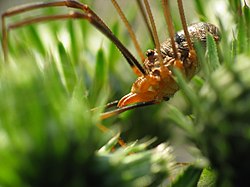| Phalangioidea | |
|---|---|
 | |
| Male Phalangium opilio | |
| Scientific classification | |
| Domain: | Eukaryota |
| Kingdom: | Animalia |
| Phylum: | Arthropoda |
| Subphylum: | Chelicerata |
| Class: | Arachnida |
| Order: | Opiliones |
| Suborder: | Eupnoi |
| Superfamily: | Phalangioidea Latrelle, 1802 |
| Families | |
See text | |
Phalangioidea is a superfamily of the harvestman suborder Eupnoi with five recognized families and more than 1,500 species. [1] [2]
It is not to be confused with the similar spelled subfamily Phalangodoidea, which is also a harvestman superfamily, but within the suborder Laniatores.